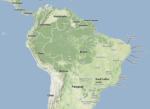An overview of South American Coffee Regions
South American coffees have a wide range of taste profiles in keeping with the expanse of geography covered in this region, roughly the northern portion of the West Coast highlands (Andes Mountains) and the southeastern highlands of Brazil inland from Sao Paulo. A lot of the world’s coffee comes from this region of the world, so we will summarize the two main areas separately.
SA West Coast Coffee: In South America’s West, the coffee world is divided between Colombia and everyone else (Peru, Bolivia and Ecuador). The best comes from smallholder and co-op farms on the slopes of the Andes, grown between 1500-2200 MASL (Meters Above Sea Level), or roughly 4500 – 6500 ft. At this altitude, the beans grow dense, and since similar varietals and processing methods are used to those in Central America, the taste profile is similar. Good Colombian coffee is often described as having
big buttery texture
toffee flavor
sweet caramel
spicy high notes or slight fruity notes
The rest of the Andean coffee growers (Peru, Bolivia and Ecuador) are rapidly developing their coffee industries capitalizing on similar growing conditions and a commitment to organic, environmentally sustainable methods. Where Colombian coffees are often bold, other Andean coffees are generally described as
sweet, mild and smooth caramelizing sugar
dark chocolate
toffee
They are best at a lighter to medium roast as a rule.
SA East Coast Coffee: We are speaking here of the southeastern highland area of Brazil, the foremost coffee producing region in the world at present (Vietnam is second now!) Here they take a very different approach from the West Coast–“highland” means roughly 900 – 1250 MASL (2750-3800 ft) in altitude, and “farm” means giant coffee coffee plantations using large-scale agribusiness techniques including mechanical picking for the most part. However, as Brazilian farmers are seeking to enter the high-end specialty market, they are also implementing more eco-friendly and socially-conscious practices (highly-correlated with the desires of their target customer in the USA, Canada and Europe).
Brazil Processing Brazilians come in two major kinds of processing that affect their fundamental profile characteristics. Wet processed, low-grown Brazils often have a mild, nutty, milk chocolaty flavor profile with a little citrus kick. Dry-processed or natural-processed Brazils (in which the pulp is left on the seed for a time) have heavier body and can provide the basis for nice espresso. In fact, most commercial espresso blends use dry-processed Brazils as a base, the “blank canvas” upon which a taste profile is built. Natural-processed Brazil often are described as
nutty
low-acid
chocolate

